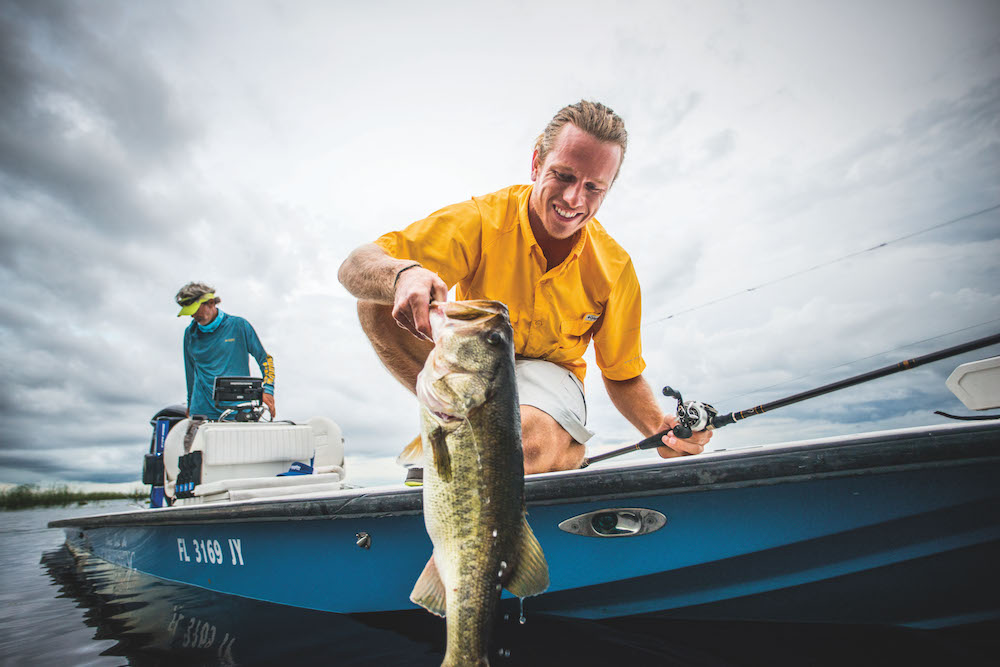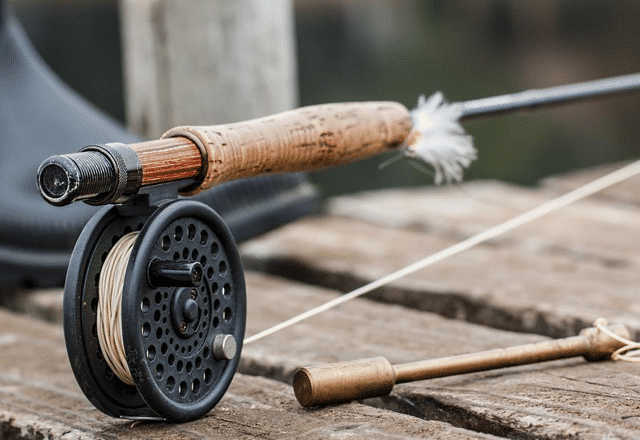When you first start out, every little accomplishment is a huge victory, and you can’t wait to get back out on the water to fish again. As you learn about the different types of fish, you begin to realize that they all handle bait differently and some are easier to catch than others.
There’s a natural progression that occurs when you fish bass. You don’t typically step out onto the boat and grab a five pounder on the first go.
That said, there are some things a beginner can do to help speed up this progression. From the best bass lures to the best bass fishing rods, we are covering it all.
Different Types of Bass

Bass is one of the most common freshwater fish in the world, and there are a variety of different types. Each bass requires a slightly different approach. It’s an advantage if you can identify each one.
There are a few ways to distinguish the types of bass—jaw length, number, and size of stripes, number of spines, and region of the country you fish.
Largemouth Bass—The upper jaw extends out past the eye, and they have spiny dorsal fins with a deep notch between them
Smallmouth Bass—The upper jaw does not extend past the eye, they have spiny dorsal fins and three dark lines on their cheek. This species has nine to ten spines on the dorsal fin.
Florida Bass—This is considered a subspecies of the largemouth. The upper jaw extends past the eye, and they have nine spines on the dorsal fin.
Redeye Bass—These have small dark spots below the lateral line and a second dorsal that appears red. Their upper jaw does not extend past the eye.
Guadalupe Bass—This bass has 10 to 12 dark lateral stripes as well as an upper jaw that does not reach past the eye.
Alabama Bass—These have lateral blotches and spiny, soft dorsal fins connected by a shallow notch.
Shoal Bass—These have an upper jaw that does not extend past the eye. They also have dark blotches that fade more as the fish ages. They look similar to redeye bass minus the red coloration.
There are more species out there, but these are the primary ones you will run into and have to identify.
Best Bass Lures

The experts know the best bass fishing lures and precisely what to use in their lakes, but what should a beginner use? You should start out with a shallow and deep diving crankbait. Bass don’t usually prefer any color over the other, so it doesn’t matter what color you choose. Your best bet for catching bass is to go for something that is naturally colored and not too flashy.
If you prefer to use a spinnerbait, that’s fine. Just go for something natural looking. Get a few different options so you can test the waters. Every location is a bit different and even though the species of bass are the same the water requires a bit of testing. Make sure you get gold blades on your spinner because it reflects the light better and aggravates the bass provoking them to bite.
Lastly, try some plastic worms. The wacky worm works well over the long-term. Worms don’t draw attention or get the bass worked up, so it often takes longer to get a catch using these. However, it’s a smart choice for beginners because it is simple to rig and anyone can fish with plastic worms.
If you want to try bass jigs, you have to pay close attention to the line and experiment with different color combinations. We don’t recommend doing this as a beginner—it’s a more complicated method. Stick with the crankbaits and the worms, and you should have no problem bringing them in.
Best Live Bait For Bass

If live bait is more your thing and you want to give it a try, there are a ton of different options that bass love.
Different types of bass require different live bait—not everything with work.
You also have to think about how you store the bait. If you use baitfish, you’ll need a live well or a bucket to keep them throughout the day.
There are a few things that small and largemouth bass are always interested in. They are:
- Minnows
- Crawfish
- Salamanders
- Worms
- Leeches
- Frogs
- Creek chubs
The primary issue people have when fishing live bait is that the bass will swallow the hook more often. Pay close attention when you fish with live bait so you can set the hook at the first sign of a nibble—before the bass swipes it up.
Minnows make for a great baitfish, and they come in a couple of different varieties. There are shiners, creek chubs, shad, and a bunch of others. Fishing with minnows may increase your chance of hooking a larger fish.
The cream of the crop when it comes to live bait fishing is the crawfish—the bass love them.
The Basics of Bass Fishing

We could overcomplicate things and give you all these methods of catching fish, but if you are starting out, you need the process that gives you the highest success rate with the least amount of trouble. This is a crankbait on a simple spinning rod. Fishing this way requires minimal skill or “touch,” as the experts call it, and knowing that you are doing everything right gives you the confidence you need.
When it comes to casting, the basic throwing and retrieving gets boring after a while so you can try playing with the bait in the water or even dragging it behind the boat (if you are in a boat). It’s best on a calm day, when the water is still. When there is little activity on the water, you can agitate the bass by bouncing the lure around the water—this is an excellent way to get them to bite.
If you are out on a cloudy, windy day or if the water is high and murky from rain the best way to reel in the bass is by casting and retrieving. The way to change it up though is to do it at an irregular pace. Reel in quickly, then stop and repeat that for a while.
Your ultimate goal as an angler should be to make your bait seem as real as possible when you fish. If the bass believes it’s alive, they will be more likely to strike it. You can do this by moving it slowly and smoothly through the water when the bass are around.
If you cast around stumps or pads, you are more likely to find bass. When you cast into these areas, try to get as close to the objects as possible so you can make a little noise when you get there. You want to draw the attention of the bass so you can proceed to egg them on.
A Few Expert Secrets

In addition to all the standard stuff, here are a few ways to get a bit of an advantage over other anglers.
Shred The Worms
Keep any plastic worms that get beat up and shredded from the fish biting at it all day. Use the ones that are all torn up because bass like to pounce on wounded prey.
Go For Red
Red is the best color to use for bass. If you think you’re casting into a highly concentrated area full of them, use a red lure. The fish think that the lure is injured and that the red color is blood, so this is a great way to trick them into biting.
Make Some Noise
We talked about this briefly before but let’s go back into it because it’s important. There are many different ways you can make noise on the water, but one great way is to stop your cast halfway and let the lure hit the water and skip a few times. This makes a lot of noise. The bass will notice, and if you have everything else in check, you are bound to get a bite.
Have any questions or concerns about bass fishing? Leave a comment below!






Come Join Bass Monkey Academy at Gander Outdoors. Monroe, Mooresville, Greensboro.
Classes held every other Tuesday night at 7 pm.
Hands on techniques for youth 7-17 years of age. To learn Bass Fishing.
Free to all youth!
Info 704-226/7127
Very informative. Thank you much….slaying Bass here in Gastonia,NC.?
We do a bit of Bass fishing down here in Australia – ours are like a freshwater Perch and look a little like smallmouth. They absolutely love and smash red earthworms – we thread them like sea worms straight down the hook and the Bass go nuts!
Enjoyed your post – thanks
Fantastic beginner’s guide! Clear, concise tips make bass fishing less daunting. Matching lures to bass types and using live bait wisely are game-changers. Can’t wait to apply these expert secrets on my next fishing adventure. Thanks for the insights!